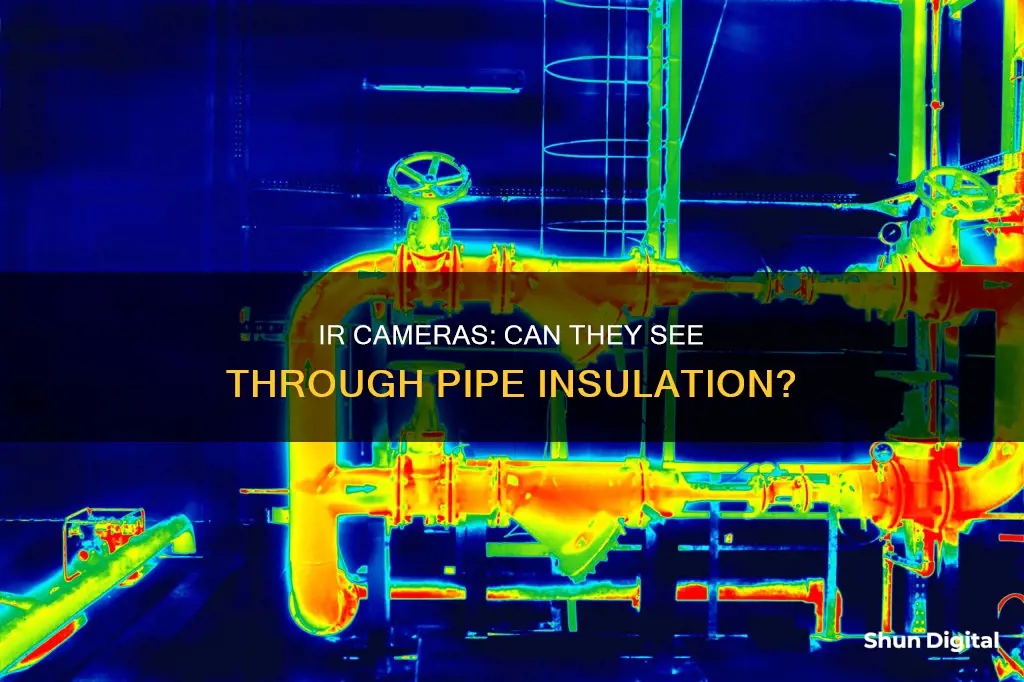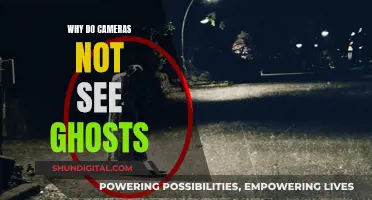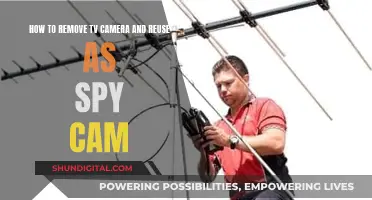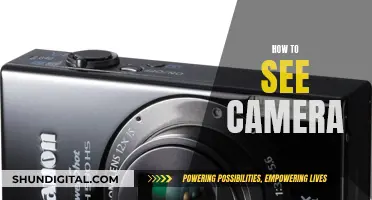
Infrared (IR) cameras are becoming an indispensable tool for home inspectors. They can be used to identify defects that may not be immediately apparent to the naked eye, such as air leaks and insulation defects. IR cameras can also be used to locate hidden pipes, as the heat from the pipes can be seen through the camera. However, it is important to note that IR cameras cannot see through solid objects like walls or concrete. Instead, they detect heat signatures that transmit from internal elements through barriers.
| Characteristics | Values |
|---|---|
| Can IR cameras see through pipe insulation? | No, but they can detect heat from pipes within walls. |
| How do IR cameras work? | IR cameras detect infrared radiation emitted by heat sources and display temperature differences as a gradient color scheme. |
| What are the benefits of using IR cameras for inspections? | IR cameras allow for quick and accurate identification of defects, such as air leaks and insulation issues, that may not be apparent to the naked eye. |
| How can IR cameras help with insulation? | IR cameras can detect areas of missing insulation by identifying temperature differences, which appear as hot or cold spots on walls or ceilings. |
| What are some specific use cases of IR cameras? | Locating hidden pipes, identifying moisture damage, and inspecting electrical receptacles, plumbing, and HVAC systems. |
What You'll Learn

IR cameras can detect insulation defects
In the context of pipe insulation, IR cameras can detect temperature anomalies that may indicate defects in the insulation. By interpreting the thermal imaging, inspectors can identify areas where heat is escaping, indicating a lack of insulation or damage to the insulating material. This is possible because IR cameras detect the subtle heat signatures that transmit from internal elements, such as pipes, through barriers like insulation.
For example, if there is a gap in the pipe insulation, the IR camera will pick up on the temperature difference between the insulated and uninsulated sections of the pipe. This will appear as a thermal irregularity in the imaging, alerting inspectors to a potential issue. Additionally, if the insulating material is damaged or defective, it may conduct heat faster, resulting in a temperature variation that can be detected by an IR camera.
The effectiveness of IR cameras in detecting insulation defects depends on several factors, including the type of insulation, the temperature differential, and the surrounding conditions. For instance, the emissivity of the surface can impact the accuracy of the reading, as highly reflective or shiny surfaces may reflect the heat of the room or the inspector instead of emitting their own infrared radiation. Therefore, it is important to understand the limitations of IR cameras and take steps to ensure accurate readings, such as maintaining specific temperature conditions and accounting for various factors that may affect the inspection.
In summary, IR cameras are a valuable tool for detecting insulation defects, especially when inspecting pipe insulation. By interpreting thermal imaging, inspectors can identify temperature anomalies that indicate a lack of insulation or damage to the insulating material. However, it is important to understand the limitations of IR technology and take the necessary steps to ensure accurate readings.
Adjusting Honda Lane Watch Camera: Tips and Tricks
You may want to see also

They can help locate hidden pipes
Infrared (IR) cameras are becoming an indispensable tool for home inspectors. They can be used to locate hidden pipes, detect air leaks, and identify insulation defects.
Infrared cameras can detect the heat from pipes hidden behind walls, floors, or other surfaces. This can be useful for locating pipes before carrying out work such as drilling or screwing into walls or floors. For example, an IR camera can show whether there are pipes hidden behind a wooden floor. The camera detects the heat from the pipes and displays it as a thermal image, with hotter areas appearing as brighter colours and cooler areas as darker colours.
When using an IR camera to locate hidden pipes, it is important to note that the camera will not "see" through solid objects. Instead, it detects the heat signatures that radiate through barriers. Therefore, the temperature difference between the interior of the house and the outside air should be as large as possible to get the best results. This can be achieved by running the heating or air conditioning to maximise the temperature difference.
In addition to locating hidden pipes, IR cameras can also be used to detect air leaks and insulation defects. By purposely controlling the temperature and air pressure inside a house, air can be forced inside through cracks and holes, and the sources of these leaks can be located using an IR camera. Areas of insufficient insulation will also appear as temperature differences in the thermal images.
Smart TVs: Are They Watching You?
You may want to see also

They can identify air leaks
Thermal imaging cameras are an invaluable tool for identifying air leaks and insulation defects. They can detect the subtle heat signatures that transmit from internal elements through barriers.
Infrared (IR) cameras are becoming indispensable for home inspectors. They allow for the quick and accurate identification of defects that may not be apparent to the naked eye. IR cameras are especially useful when looking for air leaks and insulation defects during an energy audit. By purposely controlling the temperature and air pressure inside a house, air can be forced inside through cracks and holes. Using an IR camera, the sources of these air leaks can be quickly located and documented.
Before the inspection, equipment should be checked and batteries charged. It is also helpful to move furniture away from walls and to remove curtains and blinds so that accurate readings can be taken at areas typical for leaking air, such as at floor-wall joints and window frames.
To identify air leaks, a temperature difference between the interior and exterior of a house should be established. A difference of 15° to 20º is ideal. All windows and exterior doors should be closed during testing. The heating or air conditioning should then be turned off, and the inspector should wait at least 15 minutes before commencing with the IR inspection. Once a solid difference in temperature has been established, the IR camera can identify hot and cold spots as areas that may have missing or inadequate insulation.
To find the sources of air leaks using thermal imaging, additional setup is required. By changing the air pressure of the interior in relation to the exterior, airflow can be increased to force air through cracks and holes. With the warmer or cooler air from the outside flowing into the house through these openings, inspectors can use thermal imaging to locate the sources of these air leaks.
The best way to pull air inside through cracks and holes is by using blower door equipment. If blower door equipment is unavailable, a house's exhaust fans and ventilation system can be used to create similar conditions, allowing useful data to be gathered.
Smart TVs: Cameras and Your Privacy
You may want to see also

They can be used to find moisture damage
Thermal imaging cameras are an effective way to find moisture damage in buildings. They can identify water leaks and moisture intrusion, which are among the most challenging issues to detect in a building. By employing IR cameras, inspectors can locate moisture problems before they become large issues and cause serious damage.
IR cameras can detect moisture damage in walls, ceilings, floors, and other areas where moisture can accumulate and spread in recognisable patterns. For example, moisture in walls typically spreads in a top-down triangular shape, while in ceilings, it forms an amorphous, unstructured shape with areas of wet, damp, and moist material spreading outwards with different temperatures.
In addition, thermal imaging can help inspectors locate the sources and extent of moisture intrusion. It allows for the examination of areas that are not visible to the naked eye and difficult to access, such as behind finished basement walls or above tall ceilings. It also enables inspectors to trace the moisture intrusion through other affected areas and identify wet spots in insulation.
When using IR cameras to detect moisture, it is important to consider the temperature differential between the building interior and exterior, as a greater span in temperature typically results in better thermal images. Additionally, the use of thermal imaging in building inspections combines traditional inspection techniques with infrared technology, helping to pinpoint problems more quickly and accurately.
Troubleshooting Nightowl Cameras Not Showing on TV
You may want to see also

They can be used to conduct energy audits
Infrared (IR) cameras are useful tools for conducting energy audits of buildings. They can identify issues with insulation and air leaks, which are often the culprits behind energy loss and high utility bills.
An energy audit is the first step in evaluating a building's energy use and typically consists of various home performance tests that identify areas where energy use can be reduced. IR cameras are particularly effective for this purpose because they can detect and visualise heat patterns that are invisible to the naked eye. This allows inspectors to pinpoint the exact locations of energy inefficiencies, such as missing insulation, air leaks, or malfunctioning HVAC systems.
For example, by scanning both interior and exterior walls, inspectors can identify areas where heat is escaping, indicating inadequate insulation or air leaks. This information can then be used to recommend improvements and repairs to reduce energy loss and improve energy efficiency.
IR cameras are also useful for validating the effectiveness of any repairs or improvements made. For instance, a follow-up infrared inspection can be performed after caulking, filling voids with spray foam, or adding insulation to ensure that the issues have been properly addressed.
In addition to reducing energy costs, addressing these issues can also improve occupant comfort and health. Excessive air leakage can lead to uncontrolled temperature variations and high humidity, which can impact the comfort and well-being of those occupying the building.
It is important to note that the effectiveness of IR cameras in detecting air leaks can be enhanced by creating a significant temperature difference between the inside and outside of the building. This can be achieved by conducting inspections during periods of intense heat or cold. Additionally, the use of a blower door during the inspection can help exaggerate air leaks, making them easier to detect.
Neighbor Watch: Cameras Capturing Communities
You may want to see also
Frequently asked questions
Yes, IR cameras can detect heat from pipes through walls, floors, and other solid objects. They can also identify temperature differences that indicate missing or inadequate insulation.
Small sections of missing pipe insulation can lead to significant increases in your energy bill and even cause physical damage to your home over time. Missing pipe insulation allows heat or cold to infiltrate, which shows as hot or cold spots on walls or ceilings when viewed by an IR camera.
IR cameras are non-invasive and can quickly identify problems with insulation without causing damage to walls or other surfaces. They can also be used to detect moisture and mould, which can indicate leaks or water damage.
IR cameras can be used to locate hidden pipes, identify insulation gaps, and detect leaks or water damage. For example, before driving screws through floors, you can use an IR camera to check for the presence of pipes to avoid damaging them.
It is important to ensure that the IR camera is set up correctly to detect temperature differences. This includes ensuring a significant temperature difference between the interior and exterior of the house and removing any obstructions that may block the camera's view, such as furniture, curtains, or blinds.







